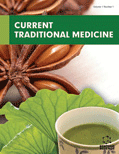Abstract
Background and Objective: In the pharmaceutical era, nanoscience and nanotechnology have been revolutionary as substantial and scientific growth with the development of several innovative nanocarriers to amplify the therapeutic worth. In particular, the invention of nanomedicine is impetuous to developing nanocarriers, enabling the phytoconstituents to encapsulate within the smart carrier to boost nanotherapeutics. Thus, herbal drugs molded-in novel nanocarriers have been extensively investigated as they are the most promising drug delivery system. Herbal-based polymeric nanoparticles are the most prominent and emerging polymeric nanocarrier that have gained much research attention in the field of novel drug delivery systems.
Methods: In herbal drug delivery technologies, the advancement of phytopharmacological science has led to the elucidation of the composition of phytoconstituents and their biological activities. By fabricating herbal medicaments in nano-size-form, there are considerable chances to circumvent poor bioavailability, in vivo degradation and toxicity, uneven drug distribution, intestinal absorption, and nonspecific site of action. The combinatorial strategy of employing both herbal drugs and nanotechnology enables potentiation of the therapeutics, reducing the required dose and unwanted toxic effects. The herbal nanosystem has the potential to convey the active constituents in a controlled manner to the targeted site with greater therapeutic value compared to the conventional system. In this current manuscript, sterling efforts were made to gather information from the existing original research papers using databases viz., Google Scholar, Pubmed, Embase, Scopus, Baidu, Web of Science, etc. Furthermore, painstaking efforts were made to compile and update potential pharmaceutical and cosmeceutical applications of herbal-based polymeric nanoparticles in the form of tables. This article portrays a comprehensive recent finding that formulation scientists are working on novel herbal nanocarriers to pave the way for future research in the field of pharmaceutical nanotechnology.
Conclusion: The herbal extracts encapsulated within the nanocapsule or nanosphere are an effective and emerging way for the herbal drug delivery to the intended site of action with pronounced therapeutic worth. Therefore, extensive scientific research is still being carried out in the field of herbal drug technology, which offers several positive aspects to impart the phytoconstituents to the intended sites and is a considerably promising herbal drug delivery system for controlled drug delivery and targeting.
Keywords: Herbal medicine, novel carrier, therapeutic efficacy, drug targeting, bioavailability, nanocapsule, nanosphere.
[http://dx.doi.org/10.1155/2014/525340] [PMID: 24872833]
[http://dx.doi.org/10.1007/s10311-018-00841-1]
[http://dx.doi.org/10.1016/S2221-1691(13)60060-X] [PMID: 23620848]
[http://dx.doi.org/10.3390/plants10061238] [PMID: 34207139]
[PMID: 24363556]
[http://dx.doi.org/10.2174/1871520620666200619171616] [PMID: 32560619]
[http://dx.doi.org/10.1186/s40824-019-0166-x] [PMID: 31832232]
[http://dx.doi.org/10.2147/IJN.S227805] [PMID: 32346289]
[http://dx.doi.org/10.4155/tde-2017-0060] [PMID: 29061102]
[http://dx.doi.org/10.3390/molecules25163731] [PMID: 32824172]
[http://dx.doi.org/10.4103/2278-344X.107832]
[http://dx.doi.org/10.2147/IJN.S146315] [PMID: 29042776]
[http://dx.doi.org/10.3390/pharmaceutics13050631] [PMID: 33925127]
[http://dx.doi.org/10.3389/fbioe.2020.00048] [PMID: 32117928]
[http://dx.doi.org/10.12980/APJTB.4.2014C980] [PMID: 25183064]
[http://dx.doi.org/10.1088/2053-1591/ac3f5e]
[http://dx.doi.org/10.1016/j.msec.2020.111035] [PMID: 32994029]
[http://dx.doi.org/10.4103/2231-4040.101006] [PMID: 23057000]
[http://dx.doi.org/10.1186/s12951-018-0392-8] [PMID: 30231877]
[http://dx.doi.org/10.4103/0973-7847.65322] [PMID: 22228938]
[http://dx.doi.org/10.1016/j.ijpharm.2013.01.019] [PMID: 23333709]
[http://dx.doi.org/10.1016/0378-5173(89)90281-0]
[PMID: 25789220]
[http://dx.doi.org/10.1016/j.trac.2015.06.014]
[http://dx.doi.org/10.3389/fphar.2018.01260] [PMID: 30450050]
[http://dx.doi.org/10.1080/00914037.2017.1405350]
[http://dx.doi.org/10.1016/j.actbio.2018.04.006] [PMID: 29653217]
[http://dx.doi.org/10.1007/s40005-019-00439-x]
[http://dx.doi.org/10.3390/nano6020026] [PMID: 28344283]
[http://dx.doi.org/10.3390/pharmaceutics12050431] [PMID: 32392726]
[http://dx.doi.org/10.3182/20090712-4-TR-2008.00064]
[http://dx.doi.org/10.1002/aic.690050421]
[http://dx.doi.org/10.1016/j.tifs.2013.10.002]
[http://dx.doi.org/10.1016/0001-8686(87)80009-X]
[http://dx.doi.org/10.1016/j.ijpharm.2017.08.064] [PMID: 28801107]
[http://dx.doi.org/10.1016/j.foodcont.2013.03.038]
[http://dx.doi.org/10.2147/IJN.S40579] [PMID: 23459088]
[http://dx.doi.org/10.3390/nano12030354] [PMID: 35159698]
[http://dx.doi.org/10.1016/j.surfrep.2017.02.001]
[http://dx.doi.org/10.1155/2015/341848]
[http://dx.doi.org/10.1002/jbm.a.36028] [PMID: 28177570]
[http://dx.doi.org/10.1039/C6CS00636A] [PMID: 28585944]
[http://dx.doi.org/10.1016/j.phrs.2019.01.013] [PMID: 30634051]
[http://dx.doi.org/10.1186/s40824-016-0081-3] [PMID: 27807476]
[http://dx.doi.org/10.1016/j.onano.2017.12.001]
[http://dx.doi.org/10.1039/C7NH00167C] [PMID: 32254078]
[http://dx.doi.org/10.1007/s11095-017-2146-y] [PMID: 28342057]
[http://dx.doi.org/10.1016/j.ijpharm.2015.04.054] [PMID: 25899283]
[http://dx.doi.org/10.1016/j.colsurfb.2014.09.002] [PMID: 25262411]
[http://dx.doi.org/10.18632/oncotarget.20944] [PMID: 29113362]
[http://dx.doi.org/10.1016/j.biomaterials.2011.04.082] [PMID: 21724247]
[http://dx.doi.org/10.1039/D1NR02065J] [PMID: 34132312]
[http://dx.doi.org/10.1080/10717544.2017.1388451] [PMID: 29069920]
[http://dx.doi.org/10.1039/C8TB00474A] [PMID: 32254661]
[http://dx.doi.org/10.1007/s11051-013-1818-8]
[http://dx.doi.org/10.1007/s40199-019-00324-w] [PMID: 31919789]
[http://dx.doi.org/10.1371/journal.pone.0206109] [PMID: 30408068]
[http://dx.doi.org/10.1016/j.biomaterials.2012.06.026] [PMID: 22795543]
[http://dx.doi.org/10.1016/j.ejps.2009.02.008] [PMID: 19429421]
[http://dx.doi.org/10.3390/cells9020273] [PMID: 31979120]
[http://dx.doi.org/10.1016/j.ajps.2014.03.001]
[http://dx.doi.org/10.1049/iet-nbt.2019.0363] [PMID: 32463025]
[http://dx.doi.org/10.1208/s12249-020-01655-7] [PMID: 32342227]
[http://dx.doi.org/10.1016/j.bbamem.2016.02.028] [PMID: 26930298]
[http://dx.doi.org/10.1038/nsb0902-646] [PMID: 12198485]
[http://dx.doi.org/10.1016/j.sbi.2007.12.007] [PMID: 18280138]
[http://dx.doi.org/10.1021/la203055t] [PMID: 21981373]
[http://dx.doi.org/10.1016/j.sbi.2012.01.011] [PMID: 22402497]
[http://dx.doi.org/10.2174/1568026614666140121112118] [PMID: 24444168]
[http://dx.doi.org/10.1021/acs.jpcb.5b00020] [PMID: 25803564]
[http://dx.doi.org/10.1021/ja204043b] [PMID: 21780810]
[http://dx.doi.org/10.1039/c001988g]
[http://dx.doi.org/10.5281/zenodo.3378213]
[http://dx.doi.org/10.1039/c2sm25538c]
[http://dx.doi.org/10.1073/pnas.1105351108] [PMID: 21690358]
[http://dx.doi.org/10.1007/s00249-010-0651-6] [PMID: 21153635]
[http://dx.doi.org/10.1021/jp108540n] [PMID: 21306175]
[http://dx.doi.org/10.1021/bm100248e] [PMID: 20536119]
[http://dx.doi.org/10.1166/jnn.2015.9735] [PMID: 26353604]
[http://dx.doi.org/10.1007/s11426-014-5231-7]
[http://dx.doi.org/10.1016/j.biomaterials.2012.03.044] [PMID: 22483010]
[http://dx.doi.org/10.1002/smll.201401943] [PMID: 25387905]
[http://dx.doi.org/10.1039/C4NR05575F] [PMID: 25585060]
[http://dx.doi.org/10.1039/c1sm06405c]
[http://dx.doi.org/10.1016/j.biomaterials.2012.04.055] [PMID: 22607914]
[http://dx.doi.org/10.3390/antiox9121309] [PMID: 33371338]
[http://dx.doi.org/10.1016/j.fitote.2010.05.001] [PMID: 20471457]
[http://dx.doi.org/10.1080/17425247.2021.1828339] [PMID: 32969740]
[http://dx.doi.org/10.1016/j.ijpharm.2014.12.017] [PMID: 25510599]
[http://dx.doi.org/10.1177/0883911519876065]
[http://dx.doi.org/10.1016/j.ejps.2012.06.018] [PMID: 22771545]
[http://dx.doi.org/10.1016/j.ijpharm.2014.11.049] [PMID: 25445992]
[http://dx.doi.org/10.1021/acsomega.8b02767]
[http://dx.doi.org/10.3390/gels7040230] [PMID: 34842729]
[http://dx.doi.org/10.1111/jfpp.14712]
[http://dx.doi.org/10.3109/10837450.2014.908302] [PMID: 24831535]
[http://dx.doi.org/10.1039/C5TB01245G] [PMID: 26617985]
[http://dx.doi.org/10.1155/2021/6663986]
[http://dx.doi.org/10.1186/1477-3155-5-3] [PMID: 17439648]
[http://dx.doi.org/10.1016/j.fct.2008.01.021] [PMID: 18308443]
[PMID: 19846921]
[http://dx.doi.org/10.1038/s41598-020-65728-0] [PMID: 32488154]
[http://dx.doi.org/10.1016/j.jconrel.2008.01.013] [PMID: 18336946]
[http://dx.doi.org/10.1080/00016350500483152] [PMID: 16809192]
[http://dx.doi.org/10.1016/j.ijpharm.2009.11.014] [PMID: 19932160]
[http://dx.doi.org/10.1007/s11095-008-9791-0] [PMID: 19034626]
[http://dx.doi.org/10.22270/jddt.v10i4-s.4332]
[http://dx.doi.org/10.15575/biodjati.v5i2.9256]
[http://dx.doi.org/10.1111/jphp.12232] [PMID: 24779896]
[http://dx.doi.org/10.1016/j.ijpharm.2007.06.036] [PMID: 17689897]































